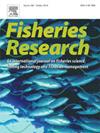Modeling the spatial distribution and abundance of deep‐water red shrimps in the Mediterranean Sea: a machine learning approach
IF 2.2
2区 农林科学
Q2 FISHERIES
引用次数: 0
Abstract
Spatially-explicit models are invaluable tools for analyzing the species-environment interactions, even at scales beyond that of direct observations. In fisheries context, the observations on species usually consist of data derived from survey campaigns, such as the Mediterranean International Bottom Trawl Surveys (MEDITS) programme. MEDITS survey foresees the use of a standardized protocol for data acquisition on demersal species, such as the blue and red shrimp Aristeus antennatus and the giant red shrimp Aristaeomorpha foliacea. These two species are recognized as highly valuable marked resources accounting for about 5 % of the trawl fishing income in the Mediterranean basin. Here, we developed a modeling framework for the analysis of the MEDITS data on those species. Within our modeling framework we aimed at detecting the existence of a divergence in the spatial patterns that could guide the definition of targeted management actions for those two valuable fishing resources. A Random Forest (RF) machine learning approach has been used to model both the occurrence (i.e., presence/absence) and the biomass index (kg/km2) of both species in four Geographical SubAreas (GSAs) located in the central part of the Mediterranean and the Ionian Sea. The RF showed high level of accuracy (i.e., K=0.83 and K=0.88, for A. antennatus and A. foliacea, respectively) in modeling species occurrence, and good level of performance (i.e., R2=0.63 and R2=0.74, respectively) in modeling their biomass index (kg/km2). The niche overlap and statistical analyses we performed on the models outputs revealed the existence of a significant divergence in the spatial patterns between these species. This provides crucial ecological knowledge for the definition of targeted (i.e., species-related) management actions. Afterwards, the models have been extrapolated at the spatial scale of the Mediterranean Sea based on an approach we defined, called hyperspace. The hyperspace approach, while showing technical and ecological soundness, was meant to guarantee the reliability of model predictions in unknown areas. It reduces the need for a proper interpretation of “what is beyond a predicted value”, offering a straightforward method for model extrapolation. Our effort aims to provide insights for prioritizing key areas in conservation strategies and marine spatial planning. It also represents an important contribution towards adopting an ecosystem-based approach to fishery resource management in the Mediterranean basin.
地中海深水红虾的空间分布和丰度建模:一种机器学习方法
空间显式模型是分析物种-环境相互作用的宝贵工具,即使在直接观察之外的尺度上也是如此。在渔业方面,对鱼种的观察通常包括来自调查运动的数据,例如地中海国际底拖网调查(MEDITS)方案。MEDITS的调查预计将使用一种标准化的方案来获取关于底栖物种的数据,例如蓝虾和红虾Aristeus antennatus以及巨大的红虾Aristaeomorpha foliacea。这两个品种被认为是极有价值的标记资源,约占地中海盆地拖网捕捞收入的5% %。在这里,我们开发了一个建模框架来分析这些物种的MEDITS数据。在我们的建模框架内,我们的目标是检测空间模式是否存在差异,从而指导对这两种宝贵的渔业资源确定有针对性的管理行动。采用随机森林(RF)机器学习方法对位于地中海中部和爱奥尼亚海的四个地理分区(gsa)中这两个物种的发生(即存在/不存在)和生物量指数(kg/km2)进行了建模。该模型在模拟物种发生方面具有较高的准确性(触角麻和叶麻分别为K=0.83和K=0.88),在模拟其生物量指数(kg/km2)方面具有较好的性能(R2=0.63和R2=0.74)。生态位重叠和统计分析结果表明,各物种间的空间格局存在显著差异。这为确定目标(即与物种有关的)管理行动提供了重要的生态知识。然后,根据我们定义的一种称为超空间的方法,这些模型在地中海的空间尺度上进行外推。超空间方法在显示技术和生态合理性的同时,旨在保证模型预测在未知领域的可靠性。它减少了对“超出预测值”的适当解释的需要,为模型外推提供了一种直接的方法。我们的努力旨在为优先考虑保护战略和海洋空间规划的关键领域提供见解。它也代表着对地中海盆地渔业资源管理采取以生态系统为基础的办法的重要贡献。
本文章由计算机程序翻译,如有差异,请以英文原文为准。
求助全文
约1分钟内获得全文
求助全文
来源期刊

Fisheries Research
农林科学-渔业
CiteScore
4.50
自引率
16.70%
发文量
294
审稿时长
15 weeks
期刊介绍:
This journal provides an international forum for the publication of papers in the areas of fisheries science, fishing technology, fisheries management and relevant socio-economics. The scope covers fisheries in salt, brackish and freshwater systems, and all aspects of associated ecology, environmental aspects of fisheries, and economics. Both theoretical and practical papers are acceptable, including laboratory and field experimental studies relevant to fisheries. Papers on the conservation of exploitable living resources are welcome. Review and Viewpoint articles are also published. As the specified areas inevitably impinge on and interrelate with each other, the approach of the journal is multidisciplinary, and authors are encouraged to emphasise the relevance of their own work to that of other disciplines. The journal is intended for fisheries scientists, biological oceanographers, gear technologists, economists, managers, administrators, policy makers and legislators.
 求助内容:
求助内容: 应助结果提醒方式:
应助结果提醒方式:


